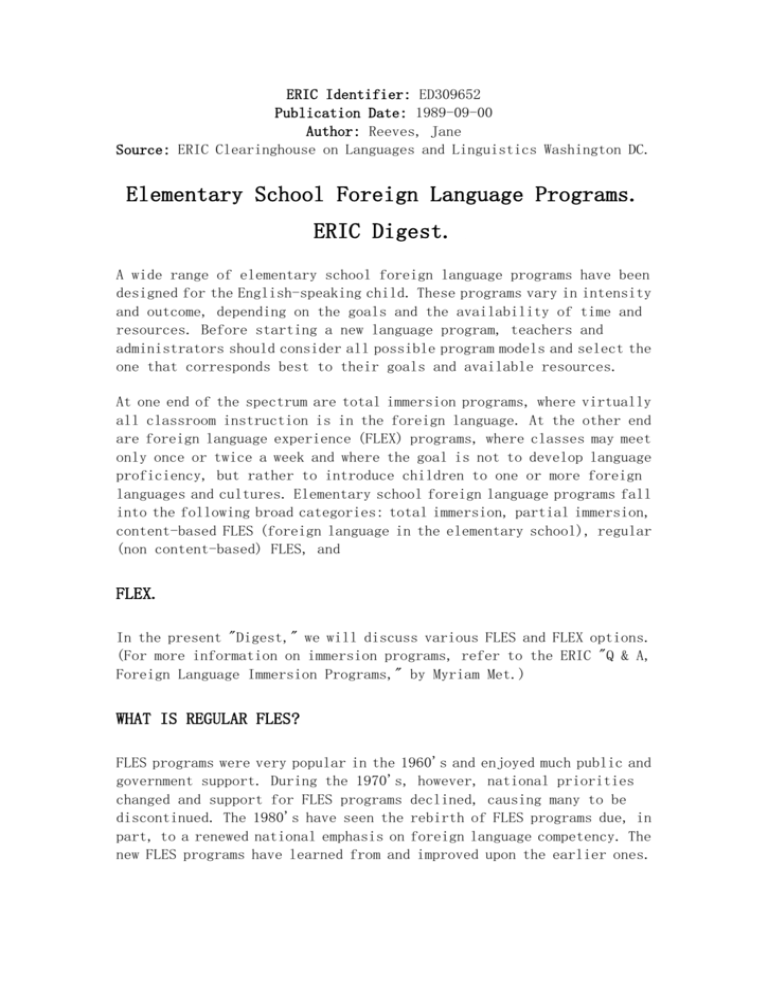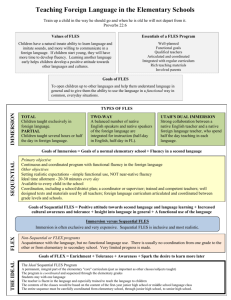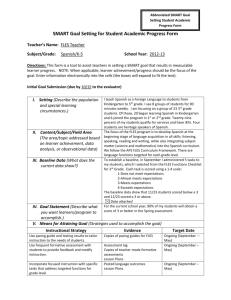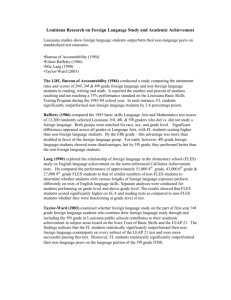ERIC Identifier: ED309652
advertisement

ERIC Identifier: ED309652 Publication Date: 1989-09-00 Author: Reeves, Jane Source: ERIC Clearinghouse on Languages and Linguistics Washington DC. Elementary School Foreign Language Programs. ERIC Digest. A wide range of elementary school foreign language programs have been designed for the English-speaking child. These programs vary in intensity and outcome, depending on the goals and the availability of time and resources. Before starting a new language program, teachers and administrators should consider all possible program models and select the one that corresponds best to their goals and available resources. At one end of the spectrum are total immersion programs, where virtually all classroom instruction is in the foreign language. At the other end are foreign language experience (FLEX) programs, where classes may meet only once or twice a week and where the goal is not to develop language proficiency, but rather to introduce children to one or more foreign languages and cultures. Elementary school foreign language programs fall into the following broad categories: total immersion, partial immersion, content-based FLES (foreign language in the elementary school), regular (non content-based) FLES, and FLEX. In the present "Digest," we will discuss various FLES and FLEX options. (For more information on immersion programs, refer to the ERIC "Q & A, Foreign Language Immersion Programs," by Myriam Met.) WHAT IS REGULAR FLES? FLES programs were very popular in the 1960's and enjoyed much public and government support. During the 1970's, however, national priorities changed and support for FLES programs declined, causing many to be discontinued. The 1980's have seen the rebirth of FLES programs due, in part, to a renewed national emphasis on foreign language competency. The new FLES programs have learned from and improved upon the earlier ones. FLES programs now focus less on the teaching of grammar, and more on the development of listening and speaking skills and on cultural awareness. Grammar is not ignored, but is learned indirectly rather than through direct instruction. FLES programs follow the natural sequence of language learning: understanding > speaking > reading > writing. The primary stress is on understanding and speaking. Instructional techniques appropriate for young children have been developed; physical activity and concrete experiences play an important role. Visuals, manipulatives, and realia are a crucial part of the FLES classroom, and the typical lesson plan includes songs, rhymes, games, play-acting with puppets, and other physical activities that appeal to the younger child. FLES classes usually meet two to five times a week for 20 to 40 minutes at a time. In some schools, classes begin in kindergarten and continue through 6th grade, while in other schools they begin in 2nd, 3rd, or 4th grade. The level of proficiency attained by the students is usually directly related to the amount of time they spend using the foreign language. WHAT IS CONTENT-BASED FLES? Content-based, or content-enriched, FLES differs from regular FLES in that subject content from the regular school curriculum is taught in the foreign language, thus the focus is not on (explicit) language instruction alone. Teachers integrate content learning with language development via activities where the main topics come from the regular curriculum content areas (i.e., social studies, mathematics, science) so that language is acquired in a meaningful context. These content-based activities can provide a framework for developing higher cognitive skills as well as a vehicle for both language learning and content learning. Because they spend more time using the foreign language and are exposed to a wider variety of topics, students in content-based FLES programs generally attain a higher level of proficiency than their counterparts in regular FLES programs. WHAT IS FLEX? The goals of FLEX programs are to introduce students to a foreign language and culture, and to motivate them to pursue further language study. Unlike FLES classes, where all or most of the instruction is in the foreign language, FLEX classes are usually conducted in English, with some basic communication in the foreign language. Obviously, fluency in the foreign language is not an objective. In some cases, students are exposed to one language and culture for the duration of the school year, while in others, a sequence of two or three languages may be offered in the course of the year. Some elementary schools offer three one-year courses, each in a different language, during the last three years of elementary school, to help students decide which language to study in secondary school. The level of proficiency achieved is much lower than in FLES classes, but FLEX can serve a useful purpose by creating enthusiasm for language study in general. WHEN AND WHERE DO CLASSES MEET? In some schools, foreign languages are part of the regular school curriculum, and classes meet during the day. In other school districts, foreign language classes are sponsored by the PTA or by an independent group of parents, and while the classes are often held on school premises, they are obliged to meet before or after the regular school day. There are advantages and disadvantages to each situation. Classes that are part of the school day have little or no drop-out problem and are legitimized by being part of the curriculum. Staffing is less of a problem as language teachers usually prefer to work during the regular school hours and be regular faculty members. Sometimes, however, schools find it difficult to fit foreign language classes into the already overflowing elementary curriculum. When classes meet before or after school, encroaching on the regular school day's time is not a problem, but these classes have to compete with other extra-curricular activities. It can be difficult to attract enough students to form a class. Staffing is more of a problem as it is often difficult to attract competent teachers who can work the necessary hours, and who are willing to spend time traveling to and from schools to teach 30 minute classes. Some language teachers have their own classroom, while others travel from one class to another. Most teachers seem to prefer having their own room, as it enables them to create a special environment without invading the space of the regular classroom teachers who usually appreciate having a period of time to work alone in their room. HOW ARE FLES AND FLEX PROGRAMS STAFFED? The lack of availability of competent language teachers who have experience working with elementary school children is often a major problem. The criteria for good FLES teachers should include native or near-native fluency in the foreign language, an understanding of the culture(s) of or associated with the language, knowledge of second language learning processes and teaching methods, and experience working with young children. It is often difficult to find enough teachers who meet all these requirements, and schools sometimes have to train teachers who meet only some of the above criteria. These teachers include: a) elementary certified teachers who speak the target language, but are not trained to teach it, b) teachers certified to teach a foreign language at the secondary level but not to teach in an elementary school, and c) native speakers without teacher certification but with prior teaching experience. In addition, in FLEX classes, where exposure rather than proficiency is the goal, one can sometimes find elementary teachers who do not speak the foreign language learning the language along with the students. When recruiting teachers for a foreign language program, it is important to remember that the students will not be able to achieve a higher degree of fluency than their teacher (assuming that their exposure to the language is limited to the classroom). WHAT MATERIALS AND RESOURCES ARE AVAILABLE? Publishers of foreign language texts have begun to heed the growing need for FLES materials. Although most programs still rely on teacher-developed materials, some authentic materials can be obtained directly from foreign countries through personal contacts or travel, other materials can be borrowed from the regular classroom, and garage sales often prove to be a good source of toys, puppets, etc. For a comprehensive list of ideas for stocking the FLES classroom, see chapter 12 of Languages and Children - Making the Match by Curtain and Pesola. Conferences and workshops held by language teaching and advocacy organizations provide parents, teachers, and administrators with the means to stay abreast of new developments in the field. FLESNews, a newsletter published three times a year by the National Network for Early Language Learning, encourages the sharing of ideas, experiences, and information among FLES teachers. Many useful documents can be found through the ERIC system (available at most libraries), and the ERIC Clearinghouse on Languages and Linguistics has produced a number of bibliographies and fact sheets on foreign languages in the elementary school. WHAT ARE THE HALLMARKS OF A SUCCESSFUL PROGRAM? Successful programs: - have community and administrative support; - are staffed by fully qualified teachers; - have well-planned curricula, designed to meet program goals; - have sufficient resources to carry out the program; and - maintain high student interest and measurable achievement. REFERENCES Anderson, H. & Rhodes, N. (1983). Immersion and other innovations in U.S. elementary schools. In: "Studies in Language Learning," v4 1983. (ERIC Document Reproduction Service No. ED 278 237) Andrade, C. & Ging, D. (1988). "Urban FLES models: Progress and promise." Cincinnati, OH: Columbus, OH: Cincinnati Public Schools, Columbus Public Schools. (ERIC Document Reproduction Service No. ED 292 337) Criminale, U. (1985). "Launching foreign language programs in elementary schools: Highpoints, headaches, and how to's." Oklahoma City, OK. (ERIC Document Reproduction Service No. ED 255 039) Curtain, H. & Pesola, C.A. (1988). "Languages and children - Making the match. Foreign language instruction in the elementary school." Reading, MA: Addison-Wesley. Thayer, Y. (1988). "Getting started with French or Spanish in the elementary school: The cost in time and money." Radford, VA: Radford City Schools. (ERIC Document Reproduction Service No. ED 294 450) The Wingspread Journal. (July 1988). "Foreign language instruction in the elementary schools." Racine, WI: The Johnson Foundation. ---FOR FURTHER READING Kennedy, D.F., & De Lorenzo, W (1985). "Complete guide to exploratory foreign language programs." Lincolnwood, IL: National Textbook Company. Lipton, G. (1988). "Practical handbook to elementary foreign language programs." Lincolnwood, IL: National Textbook Co. Lipton, G.,(1988). "So you want to have a FLES program?" Champaign, IL: National FLES Commission AATF Report. Lipton, G., Rhodes, N. & Curtain, H., Eds. (1985). "The many faces of foreign language in the elementary school: FLES, FLEX, and immersion." Champaign, IL: American Association of Teachers of French. Rhodes, N. & Schreibstein, A. (1983). "Foreign language in the elementary school: A practical guide." Washington, DC: Center for Applied Linguistics. (ERIC Document Reproduction Service No. ED 225 403) (Also available from ACTFL, Yonkers, NY). Schinke-Llano, L. (1985). "Foreign language in the elementary school: State of the art." Englewood Cliffs, NJ: Prentice Hall Regents/ Center for Applied Linguistics. (ERIC Document Reproduction Service No. ED 264 715)







